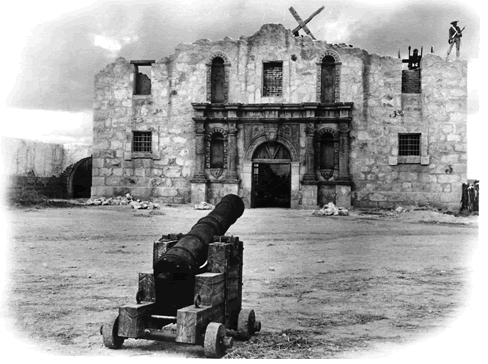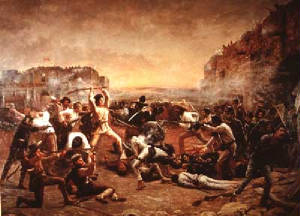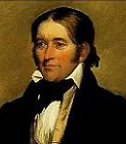|

A Brief Overview

|
Bearing the history of Texas itself, the Mission San Antonio de Valero (known as the Alamo) has passed through multiple
hands in its nearly 300-year history. It has belonged to Spain, Mexico, Texas, the United States, and the Confederacy. Though
the structure is famous for being the site of the 1836 battle between Texas revolutionary forces and the Mexican army, it
played an important role in the events that led up to that infamous battle and the later course of Texas history. The Alamo was originally established by Catholic missionaries in 1718. One of five that eventually dotted the San Antonio
landscape, it fell under the jurisdiction of the College of Santa Cruz of Querétaro. Founded to convert the area's original inhabitants -- Native American tribes including the Apache, the Karankawa, the Tacame, and the Pamaya -- to Catholicism,
it was followed by a regional military outpost, San Antonio de Béxar Presidio, and by a civilian settlement, San Fernando
de Béxar. The three settlements competed for the area's water and land resources, but joined together to defend themselves
from Native American attacks. In 1793 the Spanish Crown secularized the mission, splitting all but its religious offices among the growing Béxar community
of presidio soldiers, settlers, and Native Americans connected with the mission. In the 19th century, the structure served
a variety of functions. A mobile squadron, the compañia volante ("flying company"), quartered there and patrolled the
region. The company, from a pueblo Alamo de Parras in Coahuila, gave the mission the name of their town of origin -- and the
name stuck. Later the mission served as a hospital to the region.
After Mexico independence in 1821, the Alamo became a symbol of Mexican authority on the Texas frontier. When Santa Anna assumed the Mexican presidency and subsequently overhauled the federalist administration in favor of a centralist one, tensions
between his government and the Texans began to mount. When the tensions ignited in the Battle of Gonzales, sparked by Anglo
colonists' refusal to cede a cannon to Mexican troops, Santa Anna sent a garrison under General Martín Perfecto de Cos to
San Antonio. They seized the town and fortified the Alamo. The two-month siege ended when Anglo and Tejano revolutionaries
retaliated in a five-day attack, known as the Storming of Béxar. Cos surrendered and left Texas in disgrace in December 1835. Now in the hands of the rebels, the Alamo was the site of a particularly important election in the Tejano community.
On February 1, 1836, nearly one hundred Tejano citizens of Béxar held a meeting inside the Alamo's walls to elect who among
them would go on to Washington-on-the-Brazos as their representative at Texas' Independence Convention. They chose forty-one-year-old
José Antonio Navarro and his uncle, Colonel José Francisco Ruiz. Both men had been prominent leaders in the community for so me time. Anticipating the Mexicans' return, the Texas army fortified the Alamo. On February 23, 1836, Santa Anna and his Army
of Operations entered Béxar and the Alamo became a fortress for the rebel fighters, a hiding place for most of the women and
children of San Antonio, and a battleground. After a twelve-day seige, the compound, including its chapel, was overrun by
the Mexicans and badly damaged. In the bloody aftermath, the Alamo was littered with the bodies of its defenders, and those
of the Mexican soldiers they had killed.
After the United States annexed Texas in 1845, the U.S. military occupied the Alamo, and during a brief period during
the Civil War, it was held by the Confederacy. The late nineteenth century brought more newcomers to San Antonio, and the
city gradually built around the aging mission. In 1883 the state of Texas bought the chapel, which had survived virtually
intact from the Catholic church. In 1905 it bought the other buildings, and granted custodianship of the site to a private
organization, the Daughters of the Republic of Texas, which maintains the Alamo as a San Antonio tourist attraction today.

|
| Courtesy: Archives Division, Texas State Library |
|
 |
|

Research
Alamo Notes
....."Boys, they are going to kill us---
die with your faces to them, like men!"
the PBS website
very extensive indeed!
An excellent portrait of
Santa Anna in his 20's
The collection forms part of
the Genaro García Collection,
which was purchased by the
University of Texas
in 1921 from the heirs of
Genaro García.
five hours that changed history
The Goliad Massacre,
the tragic termination of
the Goliad Campaign of 1836,
is of all the episodes of
the Texas Revolution
the most infamous.
on The Alamo and San Jacinto
1832 - 1836
this is a very through website
on many of the aspects of the war
including The Alamo, Goliad
and San Jacinto
|
 |
|
|
 |
|
|
|

